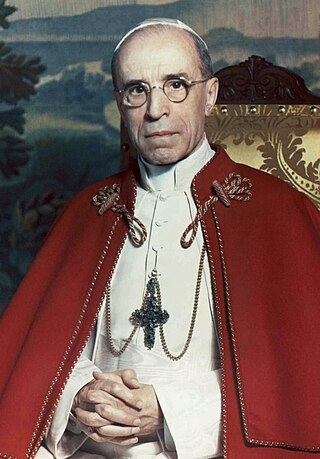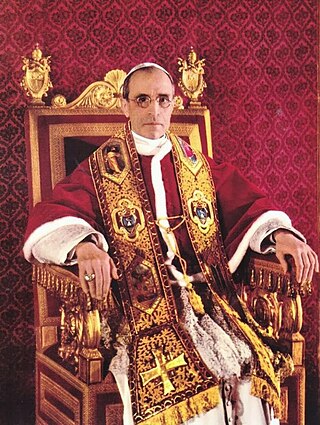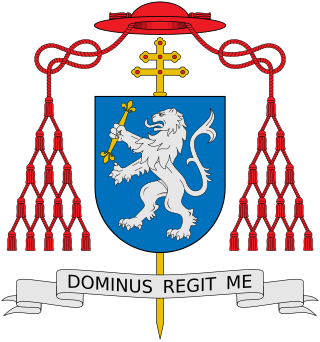
Pope Pius XII was head of the Catholic Church and sovereign of the Vatican City State from 2 March 1939 until his death in October 1958. Before his election to the papacy, he served as secretary of the Department of Extraordinary Ecclesiastical Affairs, papal nuncio to Germany, and Cardinal Secretary of State, in which capacity he worked to conclude treaties with various European and Latin American nations, including the Reichskonkordat treaty with the German Reich.
Vatican Radio is the official broadcasting service of Vatican City.

The papal conclave held on 1 and 2 March 1939 saw Cardinal Eugenio Pacelli elected on the third ballot to succeed Pius XI, who had died on 10 February, as pope. All 62 cardinals took part. Pacelli, who had been camerlengo and secretary of state, took the name Pius XII. The day was his 63rd birthday.

The Immaculate Heart of Mary is a Roman Catholic devotion which refers to the view of the interior life of Mary, her joys and sorrows, her virtues and hidden perfections, and, above all, her virginal love for God the Father, her maternal love for her son Jesus Christ, and her motherly and compassionate love for all mankind. Traditionally, the Immaculate Heart is depicted pierced with seven swords or wounds, in homage to the seven dolors of Mary and roses, usually red or white, wrapped around the heart.

The Vatican post office has operated its own postal service and issued its own postage stamps since 1929.
Munificentissimus Deus is the name of an apostolic constitution written by Pope Pius XII. It defines ex cathedra the dogma of the Assumption of the Blessed Virgin Mary. It was the first ex-cathedra infallible statement since the official ruling on papal infallibility was made at the First Vatican Council (1869–1870). In 1854 Pope Pius IX made an infallible statement with Ineffabilis Deus on the Immaculate Conception of the Virgin Mary, which was a basis for this dogma. The decree was promulgated on 1 November 1950.

Benedetto Aloisi Masella was an Italian cardinal of the Roman Catholic Church who served as prefect of the Discipline of the Sacraments from 1954 to 1968, and as chamberlain of the Roman Church from 1958 until his death. Aloisi Masella was elevated to the cardinalate in 1946 by Pope Pius XII, whom he designated to canonically crown Our Lady of Fatima.

Pietro Ciriaci was an Italian Cardinal of the Catholic Church who served as prefect of the Sacred Congregation of the Council in the Roman Curia from 1954 until his death, and was elevated to the cardinalate in 1953 by Pope Pius XII.

The Saint Paul Church in Portuguese, Igreja de São Paulo is a Portuguese 16th-century church in Braga, Portugal, dedicated to Saint Paul the Apostle of Jesus.

The Medina Museum is located in Braga, Portugal, in the same building of the Pius XII Museum

Fulgens corona is an encyclical by Pope Pius XII, given at St. Peter's, Rome, on 8 September 1953, the Feast of the Nativity of the Blessed Virgin Mary, in the fifteenth year of his Pontificate. The encyclical proclaims a Marian year for 1954, to commemorate the centenary of the definition of the dogma of the Immaculate Conception of the Virgin Mary.

The Mariology of the popes is the theological study of the influence that the popes have had on the development, formulation and transformation of the Roman Catholic Church's doctrines and devotions relating to the Blessed Virgin Mary.

Pope Pius XII consecration of the world to the Immaculate Heart of Mary took place on October 31, 1942. Pope Pius XII performed a Marian consecration, entrusting the world to the Virgin Mary, as Queen of Peace, through her Immaculate Heart.

The papacy of Pius XII began on 2 March 1939 and continued to 9 October 1958, covering the period of the Second World War and the Holocaust, during which millions of Jews were murdered by Adolf Hitler's Germany. Before becoming pope, Cardinal Pacelli served as a Vatican diplomat in Germany and as Vatican Secretary of State under Pius XI. His role during the Nazi period has been closely scrutinised and criticised. His supporters argue that Pius employed diplomacy to aid the victims of the Nazis during the war and, through directing his Church to provide discreet aid to Jews and others, saved hundreds of thousands of lives. Pius maintained links to the German Resistance, and shared intelligence with the Allies. His strongest public condemnation of genocide was, however, considered inadequate by the Allied Powers, while the Nazis viewed him as an Allied sympathizer who had dishonoured his policy of Vatican neutrality.
Yad Vashem, the state of Israel's official Holocaust memorial, has generally been critical of Pope Pius XII, the pope during The Holocaust. For decades, Pius XII has been nominated unsuccessfully for recognition as Righteous Among the Nations, an honor Yad Vashem confers on non-Jews who saved Jewish lives during the Holocaust altruistically and at risk to their own lives.
The canonization process of Pope Pius XII dates to shortly after his death in 1958. He was declared a servant of God in 1990 and venerable in 2009. Father Peter Gumpel was the relator of Pius XII's cause for canonization. The potential beatification of Pius XII has raised concern, especially by Jewish organisations, because of his controversial record during the Holocaust. The objections especially arise because of the refusal by the Vatican to allow independent access to the Vatican's archives for the period of Pius XII's papacy.

Pope Pius XII created 56 cardinals in two consistories. On both occasions Pius tried to bring the membership of the College of Cardinals to 70, the maximum established by Pope Sixtus V in 1586. The death of one cardinal meant his first consistory brought the College to 69 members, but his second consistory, through the prompt addition of another name after a cardinal-designate died, brought the number of cardinals to 70.

The Papal Palace of Castel Gandolfo, or the Apostolic Palace of Castel Gandolfo from its Italian name Palazzo Apostolico di Castel Gandolfo, is a 135-acre (54.6-ha) complex of buildings in a garden setting in the city of Castel Gandolfo, Italy, including the principal 17th-century villa, an observatory and a farmhouse with 75 acres (30.4 ha) of farmland. The main structure, the Papal Palace, has been a museum since October 2016. It served for centuries as a summer residence and vacation retreat for the pope, the leader of the Catholic Church, and is afforded extraterritorial status as one of the properties of the Holy See. It overlooks Lake Albano.
The Eastern Catholic canon law is the law of the 23 Catholic sui juris (autonomous) particular churches of the Eastern Catholic tradition. Eastern Catholic canon law includes both the common tradition among all Eastern Catholic Churches, now chiefly contained in the Code of Canons of the Eastern Churches, as well as the particular law proper to each individual sui juris particular Eastern Catholic Church. Oriental canon law is distinguished from Latin canon law, which developed along a separate line in the remnants of the Western Roman Empire, and is now chiefly codified in the 1983 Code of Canon Law.















